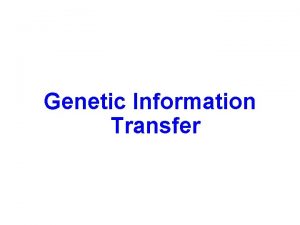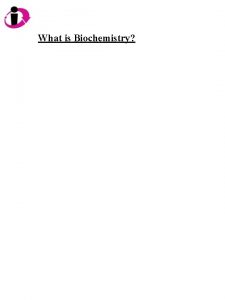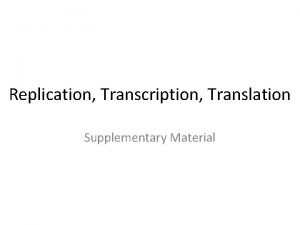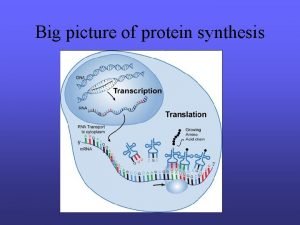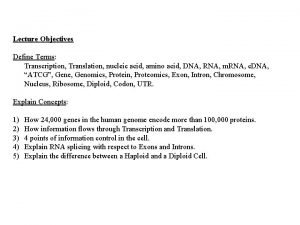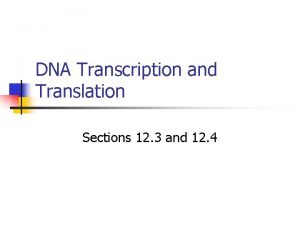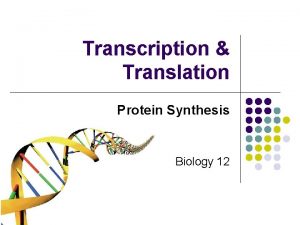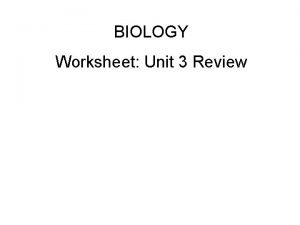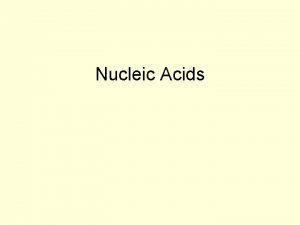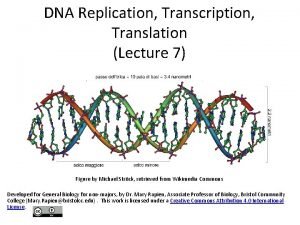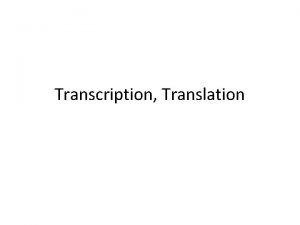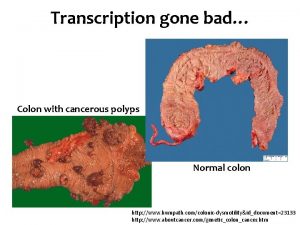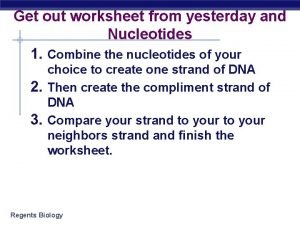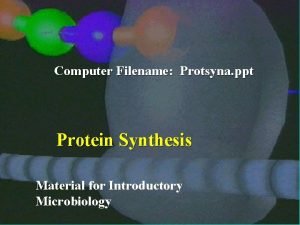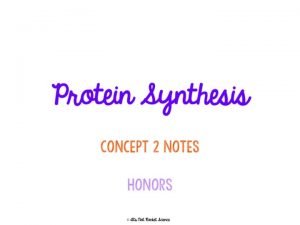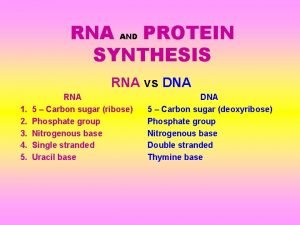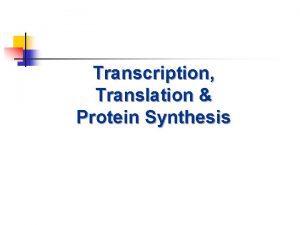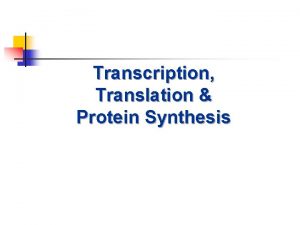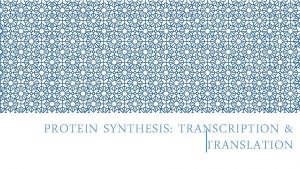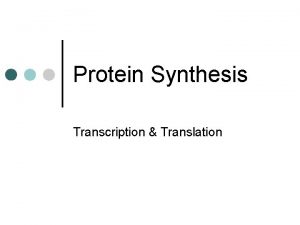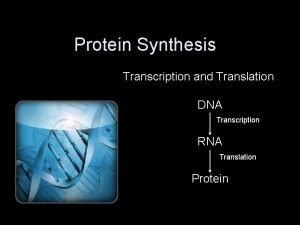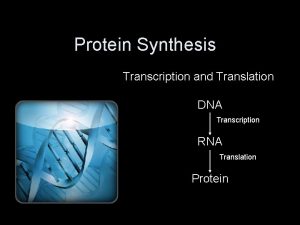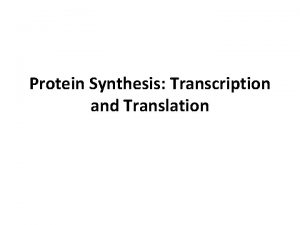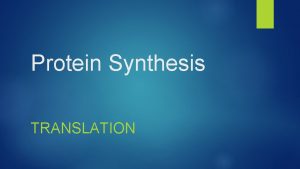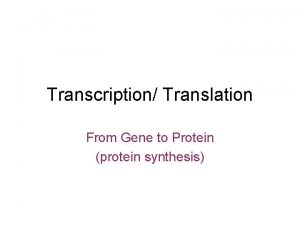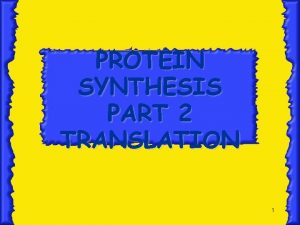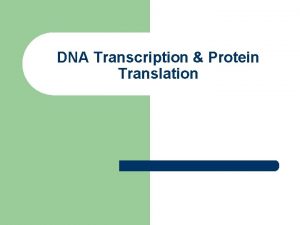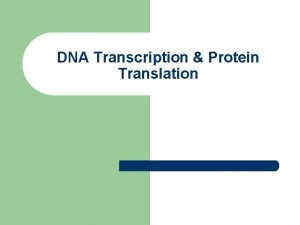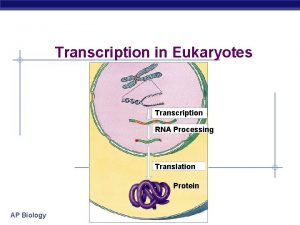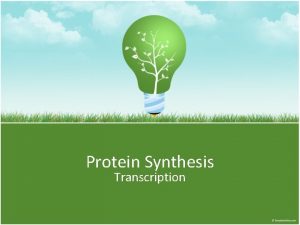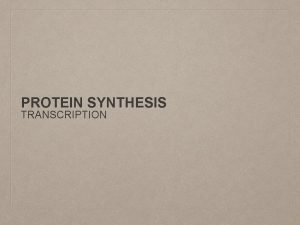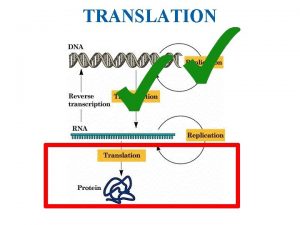Transcription Translation Protein Synthesis Protein Synthesis n n



























- Slides: 27

Transcription, Translation & Protein Synthesis

Protein Synthesis n n Protein synthesis is the process in which a cell makes protein based on the message contained within its DNA. However: n n DNA is only found in the nucleus Proteins are only made outside the nucleus – in the cytoplasm.

Protein Synthesis n n How do the many different messages within the DNA molecule get to the many ribosomes outside the nucleus? A molecular cousin of DNA – RNA – is used to carry these messages.

Ribonucleic Acids (RNA) n There are three types of RNA: 1. 2. 3. m. RNA – carries a message from the DNA to the ribosome t. RNA – transports amino acids to the m. RNA to make a protein r. RNA – make up ribosomes, which make protein.

Ribonucleic Acids (RNA) n RNA is almost exactly like DNA, except: 1. RNA has a sugar ribose DNA has a sugar deoxyribose 2. RNA contains uracil (U) DNA has thymine (T) 3. RNA molecule is single-stranded DNA is double-stranded

Ribonucleic Acids (RNA)

Protein Synthesis n Occurs in TWO steps: Transcription – the genetic information from a strand of DNA is copied into a strand of m. RNA 2. Translation – the m. RNA, with the help of the ribosome, forms a chain of amino acids (eventually forming a protein) 1.

The Central Dogma n This order of events is called the central dogma of molecular biology: DNA RNA P R O T E I N

Step One: Transcription 1. 2. 3. DNA unzips Bases pair up: Free nucleotides in the cell find their complementary bases along the new strands. What will be different? ? New backbone formed: What will be different? ?

Step One: Transcription n Watch this simplified animation: n Transcription animation

Step One: Transcription n Try it! What RNA strand will be made from the following DNA sequence? TACGCATGACTAGCAAGTCTAACT AUGCGUACUGAUCGUUCAGAUUGA

Step One: Transcription n Try it! What RNA strand will be made from the following DNA sequence? TACGCATGACTAGCAAGTCTAACT AUGCGUACUGAUCGUUCAGAUUGA

Step 1½: RNA Editing n n n An m. RNA molecule has to be “edited” because there’s a lot of unnecessary information that needs to be removed. An m. RNA sequence that does NOT code for protein is called an intron A sequence that is useful in making a protein is called an exon

Step 1½: RNA Editing DNA transcription pre-RNA (in nucleus) exon 1 interon RNA editing exon 2 interon RNA (in cytoplasm) exon 1 exon 2 exon 3

Step Two: Translation 1. 2. 3. So how do you exactly go about determining what protein your cells are going to make? FIRST, Divide the m. RNA sequence into codons. Codons are three-base sections of m. RNA: AUG|CGU|ACU|GAU|CGU|UCA|GAU|UGA

3. Translation n Three parts: 1. initiation: initiation start codon (AUG) 2. elongation: elongation 3. termination: termination stop codon (UAG)

Step Two: Translation n Watch this simplified animation: n Translation Animation

Step Two: Translation n Problem: n n There are 20 different amino acids. There are 4 RNA bases. A T C G phe ile leu val met pro ser ala thr his tyr asn gln asp lys cys glu arg trp gly

Step Two: Translation You need to figure out what amino acid matches up with each codon: 2. AUG|CGU|ACU|GAU|CGU|UCA|GAU|UGA ?

t. RNA n n A go-getter. Gets the right amino acids to make the right protein according to m. RNA instructions It contains anti-codons EX: UAC – m. RNA n AUG – t. RNA

Transfer RNA (t. RNA) amino acid attachment site methionine U A C anticodon amino acid

The Genetic Code

Step Two: Translation 2. Since each 3 -letter combination “codes” for an amino acid, you need to figure out what amino acid matches up with each codon: AUG|CGU|ACU|GAU|CGU|UCA|GAU|UGA met ?

The Genetic Code

Step Two: Translation 2. Since each 3 -letter combination “codes” for an amino acid, you need to figure out what amino acid matches up with each codon: AUG|CGU|ACU|GAU|CGU|UCA|GAU|UGA met arg thr asp arg ser asp ? ? ?

Step Two: Translation 2. Since each 3 -letter combination “codes” for an amino acid, you need to figure out what amino acid matches up with each codon: AUG|CGU|ACU|GAU|CGU|UCA|GAU|UGA met thr asp arg ser asp STOP

RECAP: 1. 2. 3. DNA is transcribed into m. RNA in the nucleus. The m. RNA leaves the nucleus and enters the cytoplasm. The protein is translated from the m. RNA sequence using t. RNA and amino acids.
 Transcription and translation
Transcription and translation Dna replication transcription and translation
Dna replication transcription and translation Overview of transcription and translation
Overview of transcription and translation Central dogma
Central dogma Protein synthesis gcse
Protein synthesis gcse Venn diagram of dna and rna
Venn diagram of dna and rna Translation transcription
Translation transcription Transcription translation replication
Transcription translation replication Translation
Translation Picture of protein synthesis
Picture of protein synthesis Dna transcription and translation
Dna transcription and translation Transcription
Transcription Transcription or translation
Transcription or translation Blood type chart
Blood type chart Biology transcription and translation
Biology transcription and translation Translation
Translation Transcription end result
Transcription end result Translation transcription
Translation transcription Complete the following venn diagram
Complete the following venn diagram Transcription and translation practice worksheet answer key
Transcription and translation practice worksheet answer key Protein synthesis ppt
Protein synthesis ppt Protein synthesis
Protein synthesis Dna protein synthesis study guide answers
Dna protein synthesis study guide answers Section 12-3 rna and protein synthesis
Section 12-3 rna and protein synthesis Dna and genes chapter 11
Dna and genes chapter 11 Protein synthesis
Protein synthesis Nucleic acid made up of
Nucleic acid made up of Pap protein synthesis worksheet
Pap protein synthesis worksheet



